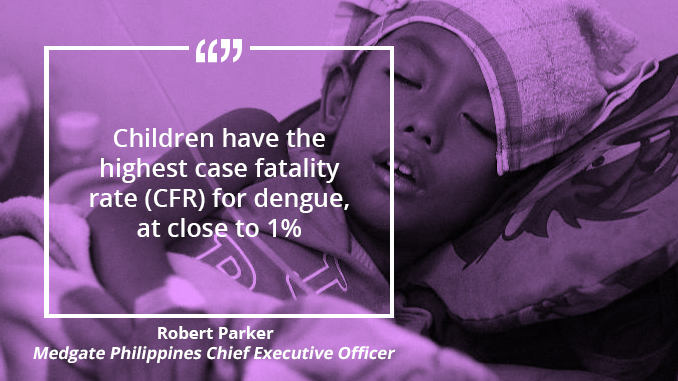Fatalities from dengue can be avoided with early detection, which is why even a fever should not be ignored–especially when young children are involved.
“Children have the highest case fatality rate (CFR) for dengue, at close to 1%,” stressed Medgate Philippines Chief Executive Officer Robert Parker, who added that this is more than double the CFR for the dreaded mosquito-borne disease, which has an average CFR of .48%.
Parker’s company, Medgate Philippines, is the leading international provider of telemedicine, with operations in Switzerland, the Middle East, Australia, and the Philippines. Telemedicine is the use of electronic communications to transmit and exchange medical information and data to treat patients. It allows people to consult doctors via their cellular phones instead of lining up at the doctor’s office.
“The numbers may not appear alarming at first glance, but when you consider that the Philippines had a total of 211,108 cases of dengue in 2016, this means that last year more than a thousand Filipinos died from a disease that is very, very treatable if detected early,” added Parker.
Data from the Department of Health-Epidemiology Bureau (DOH-EB) reveals that dengue resulted in 1,019 deaths last year, with the 1-4 age bracket recording the highest CFR at 0.98 percent. All in all, 211,108 dengue cases were recorded from January 1 to December 31, 2016.
According to Medgate Philippines Medical Director Dr. Arlene Claudio, the prevalence of dengue has made it unwise to ignore common afflictions such as a fever.
“The advantage of Medgate Philippines subscribers is that they’re able to consult a doctor the moment they suspect that they may have dengue, without having to line up for hours just to see a doctor,” explained Claudio.
“Now, if our on-call doctors determine that a caller has the symptoms associated with the disease, they can immediately advise our subscribers to go to the nearest hospital to get immediate medical attention. The faster dengue sufferers get treatment, the greater the chance the disease doesn’t become life-threatening.”
DOH Secretary Paulyn Jean Ubial, on the other hand, has emphasized the need for dengue prevention by ensuring cleanliness in our communities.
“It is very important to search and destroy the potential breeding sites in order to prevent the spread of Aedes mosquitoes that serve as vector of the virus. We reiterate that cleanliness is still the key against mosquito-borne diseases,” she said.
Ubial said that the public should be mindful of the “4S” stategy when dealing with dengue.
“The public is reminded to be vigilant and pre-cautious in eliminating mosquito breeding places through the ‘4S campaign’. The 4S means Search and destroy mosquito breeding places, use Self-protection measures, Seek early consultation for fever lasting more than two days, and Say yes to fogging only when there is an impending outbreak,” said Ubial.
Dengue is a virus transmitted by the bite of an Aedes aegypti mosquito. It is characterized by the sudden onset of high fever, which may last from two to seven days; joint and muscle pain and pain behind the eyes; weakness, skin rashes, and nose bleeding when fever starts to subside; abdominal pain, vomiting of coffee-colored matter, dark-colored stools, and difficulty in breathing.

